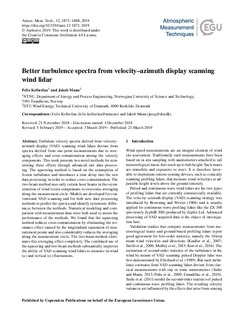| dc.contributor.author | Kelberlau, Felix | |
| dc.contributor.author | Mann, Jakob | |
| dc.date.accessioned | 2019-04-03T09:24:29Z | |
| dc.date.available | 2019-04-03T09:24:29Z | |
| dc.date.created | 2019-03-21T12:58:03Z | |
| dc.date.issued | 2019 | |
| dc.identifier.citation | Atmospheric Measurement Techniques. 2019, 12 1871-1888. | nb_NO |
| dc.identifier.issn | 1867-8548 | |
| dc.identifier.uri | http://hdl.handle.net/11250/2593091 | |
| dc.description.abstract | Turbulent velocity spectra derived from velocity–azimuth display (VAD) scanning wind lidars deviate from spectra derived from one-point measurements due to averaging effects and cross-contamination among the velocity components. This work presents two novel methods for minimizing these effects through advanced raw data processing. The squeezing method is based on the assumption of frozen turbulence and introduces a time delay into the raw data processing in order to reduce cross-contamination. The two-beam method uses only certain laser beams in the reconstruction of wind vector components to overcome averaging along the measurement circle. Models are developed for conventional VAD scanning and for both new data processing methods to predict the spectra and identify systematic differences between the methods. Numerical modeling and comparison with measurement data were both used to assess the performance of the methods. We found that the squeezing method reduces cross-contamination by eliminating the resonance effect caused by the longitudinal separation of measurement points and also considerably reduces the averaging along the measurement circle. The two-beam method eliminates this averaging effect completely. The combined use of the squeezing and two-beam methods substantially improves the ability of VAD scanning wind lidars to measure in-wind (u) and vertical (w) fluctuations. | nb_NO |
| dc.language.iso | eng | nb_NO |
| dc.publisher | European Geosciences Union | nb_NO |
| dc.rights | Navngivelse 4.0 Internasjonal | * |
| dc.rights.uri | http://creativecommons.org/licenses/by/4.0/deed.no | * |
| dc.title | Better turbulence spectra from velocity–azimuth display scanning wind lidar | nb_NO |
| dc.type | Journal article | nb_NO |
| dc.type | Peer reviewed | nb_NO |
| dc.description.version | publishedVersion | nb_NO |
| dc.source.pagenumber | 1871-1888 | nb_NO |
| dc.source.volume | 12 | nb_NO |
| dc.source.journal | Atmospheric Measurement Techniques | nb_NO |
| dc.identifier.doi | https://doi.org/10.5194/amt-12-1871-2019 | |
| dc.identifier.cristin | 1686696 | |
| dc.description.localcode | © Author(s) 2019. This work is distributed under the Creative Commons Attribution 4.0 License. | nb_NO |
| cristin.unitcode | 194,64,25,0 | |
| cristin.unitname | Institutt for energi- og prosessteknikk | |
| cristin.ispublished | true | |
| cristin.fulltext | original | |
| cristin.qualitycode | 1 | |

